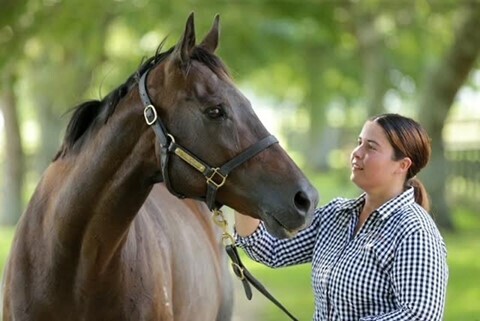Hello everyone!
It’s hard to believe, but my first four weeks in Ireland have flown by, and it's time for my first blog update. I would like to start by saying, I have so far really enjoyed my opportunity to work in the Northern Hemisphere. Before boarding the plane to Ireland, I was given a piece of advice that continues to resonate with me: "Make the most of it, take every opportunity, and ask every question". I have endeavoured to follow this piece of advice every day since I arrived, and it truly has been a remarkable journey so far, with a lot of learning along the way.
I landed in Dublin at 6 am on Sunday to rain and a high of 6 degrees! I was picked up from the airport and whisked off to start my first placement, which was to be at Coolmore Stud. Coolmore Stud is a truly remarkable operation to be a part of, even if it is just for a few months. I am based on the Main farm, just out of Fethard in Tipperary. Over the last month, I have been working in one of the mare barns alongside a small team. Our barn has 44 boxes and currently houses both Barren mares as well as mares moving straight out of the foaling unit who are going to be covered again. Our average day includes vet work, taking horses for covering, teasing, and all the general care that comes with having mares and foals, I,e feeding, farrier, treatments, holding for vets. I have especially enjoyed working with the young foals in a much more hands-on way than I am used to. This includes developing my new skill of leading the foals off their head collars as they come in and out every day! I have also enjoyed learning about the quality of the mares we have the privilege of working with.
The farm is divided up into numerous divisions, most of these being barns. Most barns are fully self-contained, with a crush, loading bay, all-weather rings, round yard/teasing shed, and a hay/straw barn, kitchen, and tack room. They are then surrounded by their own fields used for turnout. This is a huge advantage for the stud as it naturally provides isolation for the farm. This means if anything were to ever sneak past their strict procedures for horses arriving on the farm, it would be much easier to contain, which is important when you are dealing with the volume of horses here. Sometimes it is easy to forget the size and scale of the operation you are based at, as it is so quiet and peaceful around the barn. It is the perfect setting for future Coolmore champions to be raised.
When possible, I have been allowed to accompany the mares on walkouts at surrounding studs in the evenings. This so far has led me to Tally-Ho Stud, about 2 hours north of Coolmore, as well as Ballylinch Stud down in Kilkenny. I have enjoyed seeing the respective stallions the mares were visiting, as well as getting the chance to see the stud farms as well. I am looking forward to visiting a few more places during my time here including Castlehyde. Coolmore stands their stallions over two properties. Flat stallions such as Wootton Bassett, No Nay Never, Camelot, and Paddington, are stationed at the Main farm in Fethard, Tipperary, where I am based. The National Hunt and other flat stallions stand at Castlehyde, near Fermoy in County Cork, with great names such as Yeats, Hurricane Lane, and also the familiar Vadamos. We also get the chance to walk up with the mares from our barn and watch the coverings at Coolmore. I've been lucky enough to see Wootton Bassett and Camelot already. Even the covering sheds are an indication of the size of the operation. While attending my first covering with a mare, I was surprised to see there are two serving barns leading off the main crush area where they get the mares ready. As I have only had the opportunity to work in New Zealand so far, I have yet to see this at any stud. I am told they will often have both sheds going at the same time during the breeding season, and it is another reminder of the volume of horses that are coming through the stud.
The motto I often hear said is, ‘Keep it simple’ and I enjoy watching how they implement this in the day-to-day management of the stud. They have established and implemented numerous systems for sustainability and efficiency. An example of this is they collect and compost the straw to make fertilizer and effluent, which in turn is used on the farm including on trees they grow around the composting area. These trees are then turned into wood chips to be used in the all-weather rings on the farm, that are used to turn out horses in rotation with the winter fields.
This week the weather is starting to settle down and be a bit milder, which has been very nice! During my downtime, I visited my first Point-to-Point meeting. For those unfamiliar, as I most certainly was, Point to Point is a trial ground for young National Hunt horses and amateur jockeys. This week sees the running of the Cheltenham Festival, which we will all be following closely!
We have also had the chance to visit the Coolmore Museum, which is a true testament to the legacy of the stud and has some remarkable exhibits. Thank you again to everyone who has made this opportunity a reality, including NZTBA and Wentwood Grange. I look forward to what the next couple of months will bring. Over and out for now, from the 'Home of Champions'.


